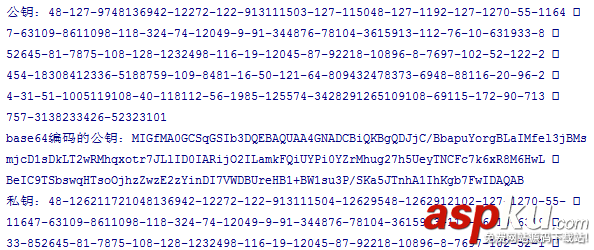一、公鑰加密和私鑰解密
/**RSA算法*/ public static final String RSA = "RSA"; /**加密方式,android的*/// public static final String TRANSFORMATION = "RSA/None/NoPadding"; /**加密方式,標準jdk的*/ public static final String TRANSFORMATION = "RSA/None/PKCS1Padding"; /** 使用公鑰加密 */ public static byte[] encryptByPublicKey(byte[] data, byte[] publicKey) throws Exception { // 得到公鑰對象 X509EncodedKeySpec keySpec = new X509EncodedKeySpec(publicKey); KeyFactory keyFactory = KeyFactory.getInstance("RSA"); PublicKey pubKey = keyFactory.generatePublic(keySpec); // 加密數據 Cipher cp = Cipher.getInstance(TRANSFORMATION); cp.init(Cipher.ENCRYPT_MODE, pubKey); return cp.doFinal(data); } /** 使用私鑰解密 */ public static byte[] decryptByPrivateKey(byte[] encrypted, byte[] privateKey) throws Exception { // 得到私鑰對象 PKCS8EncodedKeySpec keySpec = new PKCS8EncodedKeySpec(privateKey); KeyFactory kf = KeyFactory.getInstance(RSA); PrivateKey keyPrivate = kf.generatePrivate(keySpec); // 解密數據 Cipher cp = Cipher.getInstance(TRANSFORMATION); cp.init(Cipher.DECRYPT_MODE, keyPrivate); byte[] arr = cp.doFinal(encrypted); return arr; }1.data是要加密的數據,如果是字符串則getBytes。publicKey是公鑰,privateKey是私鑰。自定義密鑰對測試
String data = "hello world"; try { int keyLength = 1024; //生成密鑰對 KeyPair keyPair = RSAUtils.generateRSAKeyPair(keyLength); //獲取公鑰 byte[] publicKey = RSAUtils.getPublicKey(keyPair); //獲取私鑰 byte[] privateKey = RSAUtils.getPrivateKey(keyPair); //用公鑰加密 byte[] encrypt = RSAUtils.encryptByPublicKey(data.getBytes(), publicKey); Log.d("TAG", "加密后的數據:" + StringUtils.byteArrayToString(encrypt)); //用私鑰解密 byte[] decrypt = RSAUtils.decryptByPrivateKey(encrypt, privateKey); Log.d("TAG", "解密后的數據:" + new String(decrypt, "utf-8")); } catch (Exception e) { e.printStackTrace(); } 
2.從文件中讀取公鑰

String data = "hello world"; //讀取公鑰文件 String publicKeyString = IOUtils.readAssetsFile(this, "rsa_public_key.pem"); //base64解碼 byte[] publicKey = Base64Utils.decodeToBytes(publicKeyString); try { //加密 byte[] encrypt = RSAUtils.encryptByPublicKey(data.getBytes(), publicKey); Log.d("TAG", "加密后的數據:" + StringUtils.byteArrayToString(encrypt)); // //讀取私鑰文件// String privateKeyString = IOUtils.readAssetsFile(this, "rsa_private_key.pem");// //base64解碼// byte[] privateKey = Base64Utils.decodeToBytes(privateKeyString);// //解密// byte[] decrypt = RSAUtils.decryptByPrivateKey(encrypt, privateKey);// Log.d("TAG", "解密后的數據:" + new String(decrypt, "utf-8")); } catch (Exception e) { e.printStackTrace(); }二、公鑰分段加密和私鑰分段解密
當加密的數據過長時,會出現javax.crypto.IllegalBlockSizeException: Data must not be longer than 117 bytes的異常。rsa算法規定一次加密的數據不能超過生成密鑰對時的keyLength/8-11,keyLength一般是1024個字節,則加密的數據不能超過117個字節
/**秘鑰默認長度*/ public static final int DEFAULT_KEY_SIZE = 1024; /**加密的數據最大的字節數,即117個字節*/ public static final int DEFAULT_BUFFERSIZE = (DEFAULT_KEY_SIZE / 8) - 11; /**當加密的數據超過DEFAULT_BUFFERSIZE,則使用分段加密*/ public static final byte[] DEFAULT_SPLIT = "#PART#".getBytes(); /** 使用公鑰分段加密 */ public static byte[] encryptByPublicKeyForSpilt(byte[] data, byte[] publicKey) throws Exception{ int dataLen = data.length; if (dataLen <= DEFAULT_BUFFERSIZE) { return encryptByPublicKey(data, publicKey); } List<Byte> allBytes = new ArrayList<Byte>(2048); int bufIndex = 0; int subDataLoop = 0; byte[] buf = new byte[DEFAULT_BUFFERSIZE]; for (int i = 0; i < dataLen; i++) { buf[bufIndex] = data[i]; if (++bufIndex == DEFAULT_BUFFERSIZE || i == dataLen - 1) { subDataLoop++; if (subDataLoop != 1) { for (byte b : DEFAULT_SPLIT) { allBytes.add(b); } } byte[] encryptBytes = encryptByPublicKey(buf, publicKey); for (byte b : encryptBytes) { allBytes.add(b); } bufIndex = 0; if (i == dataLen - 1) { buf = null; } else { buf = new byte[Math .min(DEFAULT_BUFFERSIZE, dataLen - i - 1)]; } } } byte[] bytes = new byte[allBytes.size()]; int i = 0; for (Byte b : allBytes) { bytes[i++] = b.byteValue(); } return bytes; } /** 使用私鑰分段解密 */ public static byte[] decryptByPrivateKeyForSpilt(byte[] encrypted, byte[] privateKey) throws Exception { int splitLen = DEFAULT_SPLIT.length; if (splitLen <= 0) { return decryptByPrivateKey(encrypted, privateKey); } int dataLen = encrypted.length; List<Byte> allBytes = new ArrayList<Byte>(1024); int latestStartIndex = 0; for (int i = 0; i < dataLen; i++) { byte bt = encrypted[i]; boolean isMatchSplit = false; if (i == dataLen - 1) { // 到data的最后了 byte[] part = new byte[dataLen - latestStartIndex]; System.arraycopy(encrypted, latestStartIndex, part, 0, part.length); byte[] decryptPart = decryptByPrivateKey(part, privateKey); for (byte b : decryptPart) { allBytes.add(b); } latestStartIndex = i + splitLen; i = latestStartIndex - 1; } else if (bt == DEFAULT_SPLIT[0]) { // 這個是以split[0]開頭 if (splitLen > 1) { if (i + splitLen < dataLen) { // 沒有超出data的范圍 for (int j = 1; j < splitLen; j++) { if (DEFAULT_SPLIT[j] != encrypted[i + j]) { break; } if (j == splitLen - 1) { // 驗證到split的最后一位,都沒有break,則表明已經確認是split段 isMatchSplit = true; } } } } else { // split只有一位,則已經匹配了 isMatchSplit = true; } } if (isMatchSplit) { byte[] part = new byte[i - latestStartIndex]; System.arraycopy(encrypted, latestStartIndex, part, 0, part.length); byte[] decryptPart = decryptByPrivateKey(part, privateKey); for (byte b : decryptPart) { allBytes.add(b); } latestStartIndex = i + splitLen; i = latestStartIndex - 1; } } byte[] bytes = new byte[allBytes.size()]; int i = 0; for (Byte b : allBytes) { bytes[i++] = b.byteValue(); } return bytes; }測試分段加密和解密
String data = "hello world hello world hello world hello world hello world hello world hello world hello world " + "hello world hello world hello world hello world hello world hello world hello world hello world hello world " + "hello world hello world hello world hello world hello world hello world hello world hello world hello world "; Log.d("TAG", "要加密的數據:" + data + ", 要加密的數據長度:" + data.length()); try { //分段加密 byte[] encrypt = RSAUtils.encryptByPublicKeyForSpilt(data.getBytes(), publicKey); Log.d("TAG", "加密后的數據:" + StringUtils.byteArrayToString(encrypt)); //分段解密 byte[] decrypt = RSAUtils.decryptByPrivateKeyForSpilt(encrypt, privateKey); Log.d("TAG", "解密后的數據:" + new String(decrypt, "utf-8")); } catch (Exception e) { e.printStackTrace(); }三、生成密鑰對

/** 生成密鑰對,即公鑰和私鑰。key長度是512-2048,一般為1024 */ public static KeyPair generateRSAKeyPair(int keyLength) throws NoSuchAlgorithmException { KeyPairGenerator kpg = KeyPairGenerator.getInstance(RSA); kpg.initialize(keyLength); return kpg.genKeyPair(); } /** 獲取公鑰,打印為48-12613448136942-12272-122-913111503-126115048-12...等等一長串用-拼接的數字 */ public static byte[] getPublicKey(KeyPair keyPair) { RSAPublicKey rsaPublicKey = (RSAPublicKey) keyPair.getPublic(); return rsaPublicKey.getEncoded(); } /** 獲取私鑰,同上 */ public static byte[] getPrivateKey(KeyPair keyPair) { RSAPrivateKey rsaPrivateKey = (RSAPrivateKey) keyPair.getPrivate(); return rsaPrivateKey.getEncoded(); }生成公鑰和私鑰后,用base64編碼
int keyLength = 1024; try { //生成密鑰對 KeyPair keyPair = RSAUtils.generateRSAKeyPair(keyLength); //獲取公鑰 byte[] publicKey = RSAUtils.getPublicKey(keyPair); Log.d("TAG", "公鑰:" + StringUtils.byteArrayToString(publicKey)); //公鑰用base64編碼 String encodePublic = Base64Utils.encodeToString(publicKey); Log.d("TAG", "base64編碼的公鑰:" + encodePublic); //獲取私鑰 byte[] privateKey = RSAUtils.getPrivateKey(keyPair); Log.d("TAG", "私鑰:" + StringUtils.byteArrayToString(privateKey)); //私鑰用base64編碼 String encodePrivate = Base64Utils.encodeToString(privateKey); Log.d("TAG", "base64編碼的私鑰:" + encodePrivate); } catch (NoSuchAlgorithmException e) { e.printStackTrace(); } 
其它
一、android加密的數據服務器上無法解密?
android的rsa加密方式是RSA/ECB/NoPadding,而標準jdk是RSA/ECB/PKCS1Padding,所以加密時要設置標準jdk的加密方式
二、base64編碼。因為不同的設備對字符的處理方式不同,字符有可能處理出錯,不利于傳輸。所以先把數據做base64編碼,變成可見字符,減少出錯
官方提供的base64類,Base64.encode編碼,Base64.decode解碼。用這個會有換行符,需要自定義
三、rsa是非對稱加密算法。依賴于大數計算,加密速度比des慢,通常只用于加密少量數據或密鑰
四、公鑰加密比私鑰加密塊,公鑰解密比私鑰解密慢。加密后的數據大概是加密前的1.5倍
以上就是本文的全部內容,希望對大家的學習有所幫助,也希望大家多多支持VEVB武林網。
新聞熱點
疑難解答